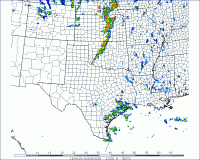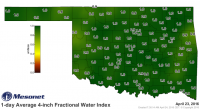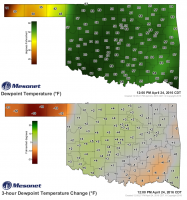It seems to me the biggest question regarding the southern play today is moisture quality. That pesky ridge sitting over the NW Gulf has finally abated, and significant return flow has begun according to the latest obs. However, solid mid-60s dewpoints are still restricted to basically right along the Texas coast. While the wind field includes many trajectories that connect this rich moisture to western Oklahoma, I'm not confident that the magnitude of the wind speed will be enough to get moisture there in time. With that said, however, I've noticed a somewhat more apparent trend in convection-allowing WRF forecasts in this case. Soil across the central and southern plains is very moist, including all throughout Oklahoma, as a result of recent widespread heavy rainfall:
View attachment 12870
Coupled with insolation that is becoming rather strong now that we're in late April, I think ground surface moisture sources will play a critical role in enhancing the moisture return today. There's more than enough moisture for significant soil evaporation and plant transpiration (ET), and recent CAM forecasts have suggested moisture will basically just appear in the low levels as the day goes on...the result of that moisture source from high ET. Most of the NCAR ensemble members from last night suggested dewpoints would reach 64+ over a narrow corridor across W OK and into SC KS by this afternoon, which is what seems to be driving the vigorous convective development in the ensemble (some impressive UH values seen in OK).
I hate to talk down about people who are doing work in the same field as I am, and I don't feel the need to do so here. I do believe that those 2-m dewpoint forecasts may verify. If they do, it will be an interesting late afternoon on the southern/central Plains. If not, well, then it probably won't be very active. I will talk down to the RAP and HRRR, though, even though the HRRR is a convection-allowing WRF. I know of the heavy amount of tuning that goes on in that model, and I continue to see evidence that the PBL scheme overmixes, so I don't really believe the moisture forecast in morning HRRR runs, although the verifying atmospheric state may resemble more of a compromise between the NCAR ensemble and the HRRR. I think lower 60s dewpoints will probably still be good enough for a show in KS/OK today, provided such 2-m dewpoint values are accompanied by a well mixed PBL.
And FWIW, the somewhat coarser (but still mesoscale) SREF (09Z run) is also fairly confident that low-mid-60s dews will appear in NW OK by this afternoon. For SC KS, that event is less certain.



